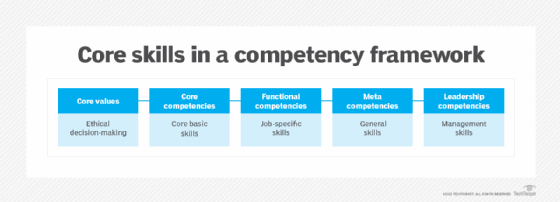competency framework
What is a competency framework?
A competency framework is a structure that defines a set of competencies, or skills, for each role in an organization. For organizations, a competency framework is a useful measure of effectiveness of employees, and for employees a competency framework is useful for clarifying the requirements for each individual role.
Competency frameworks outline the attributes, skills and knowledge needed for particular jobs. These frameworks also help organizations make informed decisions about talent recruitment, retention and succession planning and can help them support employee learning and development.
Organizations communicate to team members which behaviors are required, valued and rewarded based on their roles. This gives workers an understanding of the organization's values and the performance expected of them.
Why is a competency framework important?
A well-structured competency framework helps both employees and the organization. With this framework, employees can understand exactly what's expected of them and what competencies are needed to perform in their specific roles. If an employee is lacking in any specific area, the framework can help them identify what skills they need to focus on developing.
Competency frameworks also provide information about the organization to the employee -- such as what skills the organization values the most and how their job affects the organization.
For an organization, the framework can help talent management and human resources teams assess if an employee is effectively filling their role -- essentially, creating a benchmarking tool for each position. Creating a competency framework for a new or vacant role can also help an organization identify qualified candidates during interviews.
What are the components of a competency framework?
Although they might be constructed differently from business to business, the framework can be divided into separate competency-based qualities, such as the following:
- Core values. These set core ethical principles for employees that pertain to decision-making and behavior.
- Core competencies. These are core skills, like problem-solving, that all staff members should possess.
- Functional competencies. These are skills that relate to specific positions.
- Meta competencies. These are beneficial qualities, such as the ability to adapt to change and flexibility, that are relevant to a range of work environments but aren't directly required for employment.
- Leadership competencies. These are qualities that identify individuals who have potential leadership and management skills.
Benefits of having a competency framework
A competency framework offers the following benefits:
- Provides clear expectations. Competency frameworks provide a clear outline of the expected technical, soft and hard skills for all roles in the organization.
- Helps detect skills gaps. Managers can identify where an employee isn't fulfilling all the expected competencies for their position.
- Promotes career growth. Employees can work on any identified skills gaps for their career progression. The framework should also take staff mobility into account and how an employee can achieve certain milestones for career growth.
- Aids in the recruitment process. The framework gives recruiters a detailed list of all required and ideal skills a potential employee should have to adequately fill a particular role.
- Supports the creation of training and professional development programs. Managers can identify where their staff needs improvement and examine ways to provide mentoring and training.
How to develop a competency framework
To create a competency framework, organizations should take the following steps:
- Define the framework's purpose. Identify the intended short- and long-term goals for the framework. For example, will it be used to assess employees, to give employees an accurate description of what's expected of them, or both?
- Gather information. Relevant competencies for each role can be collected by analyzing the job itself or by asking employees. The more accurately behaviors, skills and qualifications are defined, the more precise the framework will be, and the more effective its intended use.
- Construct the framework. Using the information from the previous stage, the framework can be constructed for each position.
- Implement. The framework should be straightforward so it can be easily referenced. The organization should communicate why the framework was constructed and its goals. Training should also be provided to help fill any gaps in their specific competencies.
- Revise over time. The importance and work involved in a job role can change over time, which means the relevant competencies required also change and must be updated.

Best practices for an effective competency framework
When building a competency framework, organizations should follow these best practices:
- Be clear. Each role should include a clear but thorough explanation for each competency.
- Be extensive. Extensive analysis of each job position identifies accurate key competencies.
- Collect varying viewpoints. To help in the collection and analysis of different competencies, feedback for each role should be collected from employees, managers and subject matter experts.
- Integrate into processes. Once completed, a competency framework should be integrated into existing processes, such as in job descriptions, employee performance management processes and training.
- Provide upkeep. Competencies should be kept current, as roles can change over time.
Learn about some of the causes of IT skills gaps and how to close them with training.








